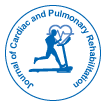Comprehensive Cardiac Rehabilitation: The Way Ahead
Received: 09-Feb-2017 / Accepted Date: 28-Feb-2017 / Published Date: 13-Mar-2017
74339Editorial
Cardiovascular Disease is still today a leading cause of morbidity and mortality in western societies. Although over the last decades cardiovascular mortality has fallen, the need for coordinated action to confront and minimize the lethal effects of the disease is ever more pressing [1,2]. Main tools used by the health care providers are Cardiovascular Disease (CVD) prevention and Cardiac Rehabilitation (CR) and are utilized in an effort to minimize cardiovascular morbidity and mortality, improve quality of life and promote a healthy lifestyle.
CVD prevention is defined as “a coordinated set of actions, at the population level or targeted at an individual, that are aimed at eliminating or minimizing the impact of CVDs and their related disabilities” [3]. Various national bodies and organizations have defined Cardiac rehabilitation which is seen as “The coordinated sum of activities required to influence favorably the underlying cause of cardiovascular disease, as well as to provide the best possible physical, mental and social conditions, so that the patients may, by their own efforts, preserve or resume optimal functioning in their community and through improved health behavior, slow or reverse progression of disease. Rehabilitation “cannot be regarded as an isolated form of therapy, but must be integrated with the whole treatment, of which it forms only one facet’’ (p 5) [4]. In the past those terms may have been used interchangeably and led to lack of precision in defining and arguing for the need for specific cardiac interventions [5].
According to current guidelines [3] prevention should be ideally delivered to the general population with the aim to enhance their general health by embracing a healthy lifestyle. It should also be delivered to patients diagnosed with CVD and to persons with a moderate to high risk of developing CVD later in life by tackling unhealthy lifestyles (e.g. unhealthy diet, sedentary lifestyle, tobacco use) and by identifying and addressing risk factors [3]. In a recent meta-analysis of 1.7 million men and women, seven major risk factors (harmful use of alcohol, insufficient physical activity, current tobacco use, raised blood pressure, intake of salt or sodium, diabetes, and obesity) are more strongly associated with cardiovascular disease mortality than with cancer and with mortality of other causes [6].
Over the last 30 years, risk factor changes (mainly lower levels of serum cholesterol, blood pressure and decreased use of tobacco) adopted by the general population had led to a reduction of in CVD mortality, although this trend has been offset by an increase in obesity and type 2 Diabetes [7,8]. The reality of clinical practice as described by the EUROASPIRE surveys is that adverse lifestyle trends in coronary patients are countering slow improvements in risk factor management, illustrating the pressing need for comprehensive prevention and rehabilitation [8].
Cardiac rehabilitation is increasingly seen as complex multifaceted interventions offered to patients with cardiovascular disease. Recent guidelines on Cardiovascular Disease Prevention in clinical practice includes the use of comprehensive programs which involves a combination of exercise training, addressing and modifying risk factors and providing educational and psychological support for patients with established CVD [3]. Such programs should be initialized while in acute care and continue following discharge. Comprehensive cardiac rehabilitation programs include a range of approaches at different points during the illness lifespan including clinical assessments to guide and optimize medical therapy, risk factor modification utilizing individualized behavioral education and exercise [3]. Education should be person-centered and extended to family members or caregivers, [9] while early mobilization and physical conditioning programs should be tailored to the individual’s clinical status [3].
A substantial body of evidence has been published in the area of cardiac rehabilitation for individuals after myocardial infarction and and for those with heart failure. Results from an overview of six Cochrane systematic reviews of CR (148 RCTs with 98 093 subjects) concluded that exercise-based cardiac rehabilitation when compared with usual care decreased hospital admissions and improved health-related quality of life for patients with Heart Failure who classes as low to moderate risk and post-myocardial infarction or revascularization patients, and also may reduce mortality in the long term [10]. Traditionally CR was exercise-based but the distinction between exercise based cardiac rehabilitation and secondary prevention is considered artificial. As evidenced by a recent metaanalysis, integrating prevention and rehabilitation to provide truly comprehensive programs is critical to achieving best patient outcomes; reducing myocardial infarction, stroke, cardiovascular and all-cause mortality [11].
Comprehensive cardiac rehabilitation programs are increasingly recognized as an intrinsic element of cardiac care. Such programs should prioritize low-fit patients and increasingly focus on facilitating long term behavior change (e.g., promoting lifestyle physical activity) and risk reduction by incorporating new approaches such as homebased, internet-based, and telephone-based CR programs [12]. Across Europe only 44.8% of coronary patients are advised to participate in any form of rehabilitation, and with an attendance rate of 81.4% only 36.5% of all eligible patients currently access any program [13]. Tele-rehabilitation is a promising novel way that could potentially widen participation to more patients while provide monitoring and individualized behavioral support [3].
References
- British Heart Foundation, European cardiovascular disease statistics 2012.
- World Health Organization, Needs and action priorities in cardiac rehabilitation and secondary prevention in patients with CHD. 1993, WHO Regional Office for Europe: Copenhagen.
- Roth G (2015) Demographic and epidemiologic drivers of global cardiovascular mortality. N Engl J Med 372: 1333-1341.
Citation: Zetta S (2017) Comprehensive Cardiac Rehabilitation: The Way Ahead. J Card Pulm Rehabil 1:e001.
Copyright: © 2017 Zetta S. This is an open-access article distributed under the terms of the Creative Commons Attribution License, which permits unrestricted use, distribution, and reproduction in any medium, provided the original author and source are credited.
Share This Article
Open 91جزة« Journals
Article Usage
- Total views: 3158
- [From(publication date): 0-2017 - May 07, 2025]
- Breakdown by view type
- HTML page views: 2300
- PDF downloads: 858
